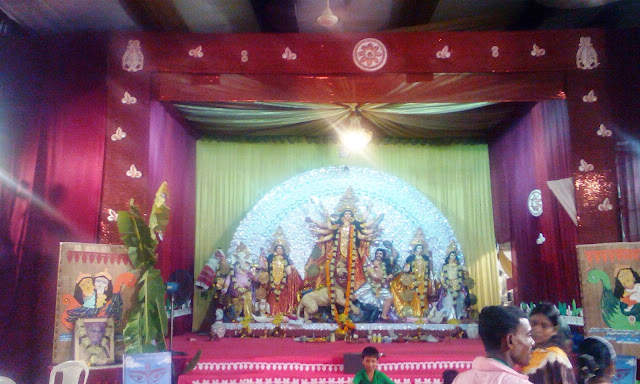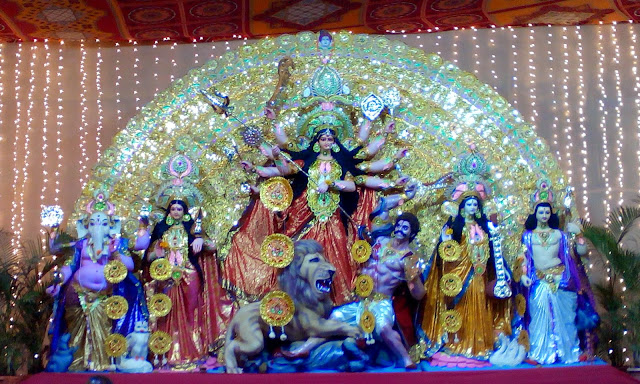I am copy pasting the mail (as it is a forwarded mail, I hope there is no copyright issue).
"Most modern Indian cities strive to rise above ethnicity. Tell anybody who
lives in Bombay that he lives in a Maharashtrian city and (unless of course,
you are speaking to Bal Thackeray) he will take immediate offence. We are
cosmopolitan, he will say indigenously. Tell a Delhiwalla that his is a
Punjabi city (which, in many ways, it is) and he will respond with much
self-righteous nonsense about being the nation's capital, about the
international composition of the city's elite etc. And tell a Bangalorean
that he lives in a Kannadiga city and you'll get lots of techno-gaff about
the internet revolution and about how Bangalore is even more cosmopolitan
than Bombay.
But, the only way to understand what Calcutta is about, is to recognize that
the city is essentially Bengali. What's more, no Bengali minds you saying
that. Rather, he is proud of the fact. Calcutta's strengths and weaknesses
mirror those of the Bengali character. It has the drawbacks: the sudden
passions, the cheerful chaos, the utter contempt for mere commerce, the
fiery response to the smallest provocation. And it has the strengths
(actually, I think of the drawbacks as strengths in their own way). Calcutta
embodies the Bengali love of culture; the triumph of intellectualism over
greed; the complete transparency of all emotions, the disdain with which
hypocrisy and insincerity are treated; the warmth of genuine humanity; and
the supremacy of emotion over all other aspects of human existence.
That's why Calcutta is not for everyone. You want your cities clean and
green; stick to Delhi. You want your cities, rich and impersonal, go to
Bombay. You want them high-tech and full of draught beer, Bangalore's your
place. But if you want a city with a soul, come to Calcutta.
When I look back on the years I've spent in Calcutta - and I come back so
many times each year that I often feel I've never been away - I don't
remember the things that people remember about cities. When I think of
London, I think of the vast open spaces of Hyde Park. When I think of New
York, I think of the frenzy of Times Square. When I think of Tokyo, I think
of the bright lights of Shinjiku. And when I think of Paris, I think of the
Champs Elysee. But when I think of Calcutta, I never think of any one place.
I don't focus on the greenery of the maidan, the beauty of the Victoria
Memorial, the bustle of Burra Bazar or the splendour of the new Howrah
'Bridge'. I think of people. Because, finally, a city is more than bricks
and mortars, street lights and tarred roads. A city is the sum of its
people. And who can ever forget -or replicate - the people of Calcutta?
When I first came to live here, I was told that the city would grow on me.
What nobody told me was that the city would change my life. It was in
Calcutta that I learnt about true warmth; about simple human decency; about
love and friendship; about emotions and caring; about truth and honesty. I
learnt other things too. Coming from Bombay as I did, it was a revelation to
live in a city where people judged each other on the things that really
mattered; where they recognized that being rich did not make you a better
person - in fact, it might have the opposite effect. I learnt also that if
life is about more than just money, it is about the things that other cities
ignore; about culture, about ideas, about art, and about passion. In Bombay,
a man with a relatively low income will salt some of it away for the day
when he gets a stock market tip. In Calcutta, a man with exactly the same
income will not know the difference between a debenture and a dividend. But
he will spend his money on the things that matter. Each morning, he will
read at least two newspapers and develop sharply etched views on the state
of the world. Each evening, there will be fresh (ideally, fresh-water or
river) fish on his table. His children will be encouraged to learn to dance
or sing. His family will appreciate the power of poetry. And for him,
religion and culture will be in inextricably bound together.
Ah religion! Tell outsiders about the importance of Puja in Calcutta and
they'll scoff. Don't be silly, they'll say. Puja is a religious festival.
And Bengal has voted for the CPM since 1977. How can godless Bengal be so
hung up on a religions festival? I never know how to explain them that to a
Bengali, religion consists of much more than shouting Jai Shri Ram or
pulling down somebody's mosque. It has little to do with meaningless ritual
or sinister political activity. The essence of Puja is that all the passions
of Bengal converge: emotion, culture, the love of life, the warmth of being
together, the joy of celebration, the pride inartistic ex-pression and yes,
the cult of the goddess.
It may be about religion. But is about much more than just worship. In which
other part of India would small, not particularly well-off localities, vie
with each other to produce the best pandals? Where else could puja pandals
go beyond religion to draw inspiration from everything else? In the years I
lived in Calcutta, the pandals featured Amitabh Bachchan, Princes Diana and
even Saddam Hussain! Where else would children cry with the sheer emotional
power of Dashimi, upset that the Goddess had left their homes? Where else
would the whole city gooseflesh when the dhakis first begin to beat their
drums? Which other Indian festival - in any part of the country - is so much
about food, about going from one roadside stall to another, following your
nose as it trails the smells of cooking?
To understand Puja, you must understand Calcutta. And to understand Calcutta, you must understand the Bengali. It's not easy. Certainly, you can't do it
till you come and live here, till you let Calcutta suffuse your being,
invade your bloodstream and steal your soul. But once you have, you'll love
Calcutta forever. Wherever you go,a bit of Calcutta will go with you. I
know, because it's happened to me. And every Puja, I am overcome by the
magic of Bengal. It's a feeling that'll never go away".





































